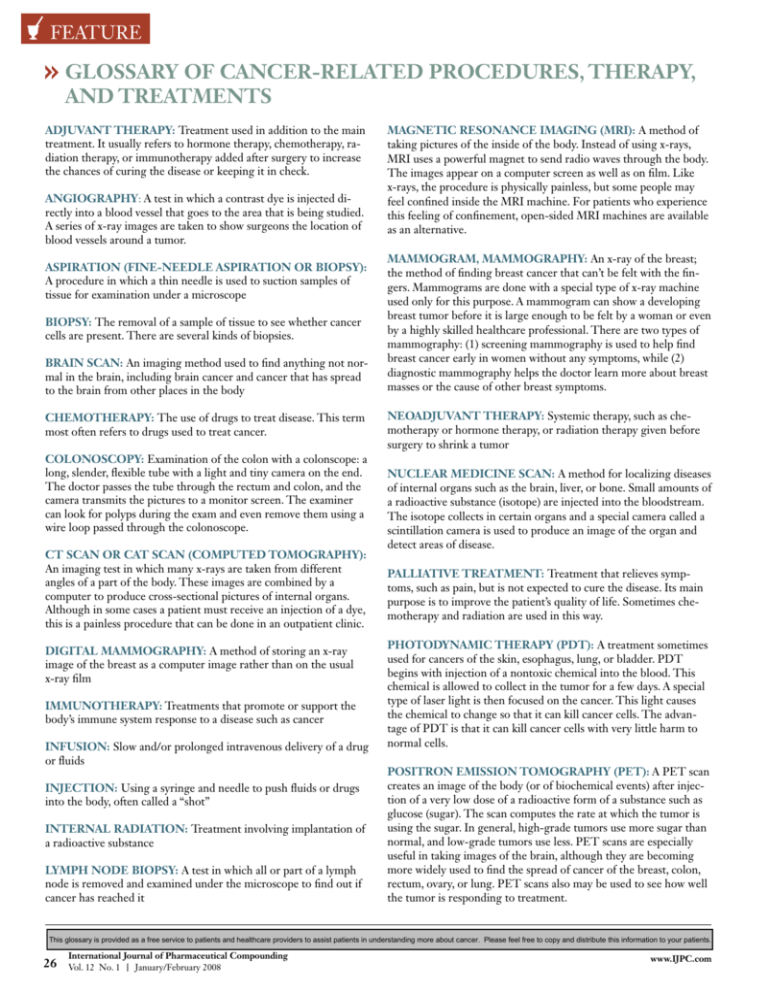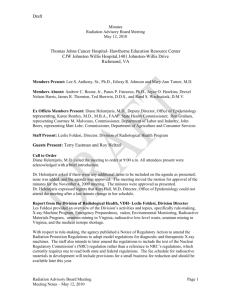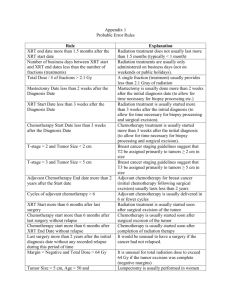Cancer-Related Procedures, Therapy, and Treatments
advertisement

FEATURE Glossary of Cancer-Related Procedures, Therapy, and Treatments Adjuvant therapy: Treatment used in addition to the main treatment. It usually refers to hormone therapy, chemotherapy, radiation therapy, or immunotherapy added after surgery to increase the chances of curing the disease or keeping it in check. Angiography: A test in which a contrast dye is injected directly into a blood vessel that goes to the area that is being studied. A series of x-ray images are taken to show surgeons the location of blood vessels around a tumor. Aspiration (fine-needle aspiration or biopsy): A procedure in which a thin needle is used to suction samples of tissue for examination under a microscope Biopsy: The removal of a sample of tissue to see whether cancer cells are present. There are several kinds of biopsies. Brain scan: An imaging method used to find anything not normal in the brain, including brain cancer and cancer that has spread to the brain from other places in the body Chemotherapy: The use of drugs to treat disease. This term most often refers to drugs used to treat cancer. Colonoscopy: Examination of the colon with a colonscope: a long, slender, flexible tube with a light and tiny camera on the end. The doctor passes the tube through the rectum and colon, and the camera transmits the pictures to a monitor screen. The examiner can look for polyps during the exam and even remove them using a wire loop passed through the colonoscope. CT scan or CAT scan (computed tomography): An imaging test in which many x-rays are taken from different angles of a part of the body. These images are combined by a computer to produce cross-sectional pictures of internal organs. Although in some cases a patient must receive an injection of a dye, this is a painless procedure that can be done in an outpatient clinic. Digital mammography: A method of storing an x-ray image of the breast as a computer image rather than on the usual x-ray film Immunotherapy: Treatments that promote or support the body’s immune system response to a disease such as cancer Infusion: Slow and/or prolonged intravenous delivery of a drug or fluids Injection: Using a syringe and needle to push fluids or drugs into the body, often called a “shot” Internal radiation: Treatment involving implantation of a radioactive substance Lymph node biopsy: A test in which all or part of a lymph node is removed and examined under the microscope to find out if cancer has reached it Magnetic resonance imaging (MRI): A method of taking pictures of the inside of the body. Instead of using x-rays, MRI uses a powerful magnet to send radio waves through the body. The images appear on a computer screen as well as on film. Like x-rays, the procedure is physically painless, but some people may feel confined inside the MRI machine. For patients who experience this feeling of confinement, open-sided MRI machines are available as an alternative. Mammogram, mammography: An x-ray of the breast; the method of finding breast cancer that can’t be felt with the fingers. Mammograms are done with a special type of x-ray machine used only for this purpose. A mammogram can show a developing breast tumor before it is large enough to be felt by a woman or even by a highly skilled healthcare professional. There are two types of mammography: (1) screening mammography is used to help find breast cancer early in women without any symptoms, while (2) diagnostic mammography helps the doctor learn more about breast masses or the cause of other breast symptoms. Neoadjuvant therapy: Systemic therapy, such as chemotherapy or hormone therapy, or radiation therapy given before surgery to shrink a tumor Nuclear medicine scan: A method for localizing diseases of internal organs such as the brain, liver, or bone. Small amounts of a radioactive substance (isotope) are injected into the bloodstream. The isotope collects in certain organs and a special camera called a scintillation camera is used to produce an image of the organ and detect areas of disease. Palliative treatment: Treatment that relieves symptoms, such as pain, but is not expected to cure the disease. Its main purpose is to improve the patient’s quality of life. Sometimes chemotherapy and radiation are used in this way. Photodynamic therapy (PDT): A treatment sometimes used for cancers of the skin, esophagus, lung, or bladder. PDT begins with injection of a nontoxic chemical into the blood. This chemical is allowed to collect in the tumor for a few days. A special type of laser light is then focused on the cancer. This light causes the chemical to change so that it can kill cancer cells. The advantage of PDT is that it can kill cancer cells with very little harm to normal cells. Positron emission tomography (PET): A PET scan creates an image of the body (or of biochemical events) after injection of a very low dose of a radioactive form of a substance such as glucose (sugar). The scan computes the rate at which the tumor is using the sugar. In general, high-grade tumors use more sugar than normal, and low-grade tumors use less. PET scans are especially useful in taking images of the brain, although they are becoming more widely used to find the spread of cancer of the breast, colon, rectum, ovary, or lung. PET scans also may be used to see how well the tumor is responding to treatment. This glossary is provided as a free service to patients and healthcare providers to assist patients in understanding more about cancer. Please feel free to copy and distribute this information to your patients. 26 International Journal of Pharmaceutical Compounding Vol. 12 No. 1 | January/February 2008 www.ijpc.com FEATURE IJPC Radiation therapy: The use of high-energy rays or subatomic particles to treat disease. Types of radiation include x-ray, electron beam, alpha and beta particles, and gamma ray. Scan: A study using either x-rays or radioactive isotopes to produce images of internal body organs Radioactive implant: A source of high-dose radiation that is placed directly into or around a tumor to kill the cancer cells Spinal tap (lumbar puncture or LP): A procedure in which a thin needle is placed in the spinal canal to withdraw a small amount of spinal fluid or to give medicine into the central nervous system through the spinal fluid Radiofrequency ablation (RFA): Treatment that uses high-energy radio waves to heat and destroy abnormal tissues. A thin, needle-like probe is guided into the tumor by ultrasound or CT scan. The probe releases a high-frequency current that heats and destroys cancer cells. RFA is sometimes used to treat tumors in the liver and is being studied for use in several other areas of the body. Stereotactic radiosurgery: A new treatment method that focuses high doses of radiation on a tumor while limiting the exposure that normal tissue receives. The treatment may be useful for tumors that are in places where regular surgery would harm essential tissue, for example, in the brain or spinal cord, or when the patient’s condition does not permit regular surgery. Radionuclide bone scan: An imaging test that uses a small amount of radioactive contrast material given in the vein. The radioactive material settles in “hot spots,” areas of bone to which the cancer may have spread, and shows up in the picture. Rescue treatment: Procedures or treatments such as bone marrow transplantation that “rescue” a patient’s immune system and blood-forming organs from the effects of high-dose chemotherapy Systemic therapy: Treatment that reaches and affects cells throughout the body (e.g., chemotherapy) Ultrasound: An imaging method in which high-frequency sound waves are used to outline a part of the body. The sound wave echoes are picked up and displayed on a television screen. Urine cytology: Examination of urine under a microscope to look for cancerous and precancerous cells This glossary is provided as a free service to patients and healthcare providers to assist patients in understanding more about cancer. Please feel free to copy and distribute this information to your patients. www.ijpc.com International Journal of Pharmaceutical Compounding Vol. 12 No. 1 | January/February 2008 27









